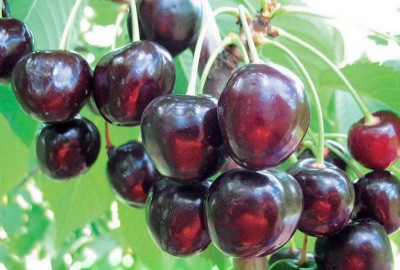
- Fruit shape: obtuse or cordate, laterally compressed
- Foliage: good
- Peduncle: length 25-35 mm, thickness 1 mm
- Authors: AND I. Voronchikhina (Rossoshanskaya zonal experimental gardening station)
- Appeared when crossing: Leningrad Black x Valery Chkalov
- Growth type: vigorous
- Appointment: for fresh consumption
- Crown: broadly oval or round, of medium density
- Escapes: straight, greenish in the shade, greenish-brown in the sun, with a slight silvery tint at the base, small lentils
- Sheet: elongated oval or elongated obovate, pointed, leathery, dark green above, glabrous, slightly glossy, slightly concave, grayish green below, slightly pubescent
Early varieties of sweet cherries are in special demand among summer residents and farmers when choosing a variety for cultivation. The list of popular and many favorite varieties includes Olenka cherry of domestic selection.
Breeding history
Olenka is an early variety that appeared at the Rossoshansk zonal experimental gardening station. The author of the variety is the well-known breeder A. Ya. Voronchikhina. The varieties Leningradskaya Black and Valery Chkalov were used as parental forms for crossing. In 1995, the stone fruit culture was accepted for state testing. The variety is zoned in the Central Black Earth region. Cherry Olenka is massively grown in the Belgorod and Voronezh regions.
Description of the variety
The deer is a vigorous tree that grows up to 5 meters in height in a healthy environment. Cherry has a rounded or broadly oval crown of good thickening with dark green leaves, upright shoots of greenish-brown color and moderate branching.
The tree blooms early - in the first week of May. During this period, the crown is densely covered with voluminous snow-white flowers, turning pink by the end of flowering. Flowers are neatly collected in inflorescences of 2-3 pieces. It is due to the incredible beauty during flowering that the tree is called fruit and ornamental.
Fruit characteristics
Sweet cherry has an attractive presentation. Large-fruited berries are characterized by a heart-shaped or blunt-hearted shape with a noticeable compression on the sides. A healthy tree grows berries weighing more than 7 grams (7.3 g). Ripe cherries are beautifully colored dark red, almost black, without subcutaneous dots. The skin of the berries is of medium density, smooth, without edges, with a clear gloss. The abdominal suture is poorly expressed.
The cherries stick on an elongated stalk, from which they break off without damaging the skin of the berries. Preserving the integrity of the berries allows them to be transported over long distances, as well as stored in a cool place for 5-6 days. The purpose of cherries is universal - they are eaten fresh, used in cooking (baked goods, compotes), canned, processed into jam, marmalade, and also frozen.
Taste qualities
Olenka is famous for its incredible taste. The dark red flesh with light veins has a tender, fleshy, moderately firm and juicy flesh. The berry has a noble and balanced taste - pleasant sweetness goes well with cool sourness. Dark cherry juice has a rich and thick flavor. The large bone is easily separated from the pulp.
Ripening and fruiting
The cherry is early ripe.The tree gives its first harvest in the 4-5th year after planting. The berries ripen together, so fruiting is not prolonged. The active maturation phase begins in mid-June and lasts 5-7 days.

Yield
The yield indicators for the sweet cherry variety Olenka are good. On average, 27-40 kg of berries can be removed from one tree per season. The maximum yield was noted at 44 kg.
Self-fertility and the need for pollinators
The variety is self-fertile, so you should think about planting donor trees. Pollinating varieties with similar flowering times are considered optimally productive. In addition, cherry trees with early flowering will be beneficial. The distance between plantings should be 3-4 meters.
Growing and care
It is recommended to plant a cherry tree in the spring (before the growing season). The plot is chosen flat, without lowlands and swampiness, cleared of weeds. You need to plant a seedling in the southeastern or southwestern part so that the tree is light and warm. Do not forget about protection from drafts and cold winds. It is also important to remember that Olenka cherries are voluminous and require a lot of space.
Intensive agricultural technology includes the following procedures: regular watering, application of nitrogen, potassium and phosphorus fertilizers, loosening and weeding of the soil, sanitary pruning of branches, crown formation, disease prevention, and preparation of the tree for winter.




Disease and pest resistance
The variety has a high immune system. Sweet cherry practically never undergoes moniliosis and coccomycosis. It is extremely rare for a tree to suffer from spotting, brown rot and scab.

Requirements for soil and climatic conditions
Olenka is characterized by moderate frost resistance, so it is not grown in regions with severe winters. In addition, the tree grows easily in heat and short drought. Long-term shading and excess moisture are negatively reflected in the development of sweet cherry.
It is most comfortable for a tree to grow on loam, sandy loam, chernozem and sod-podzolic soils with deep groundwater flow. The soil should be fluffy, breathable, fertile, moisturized, with low acidity.
































































